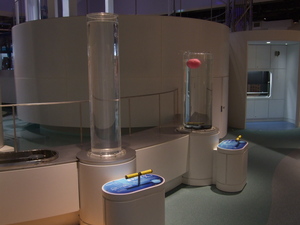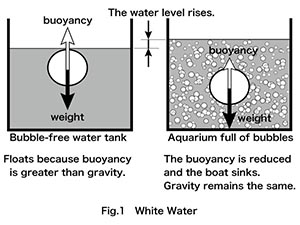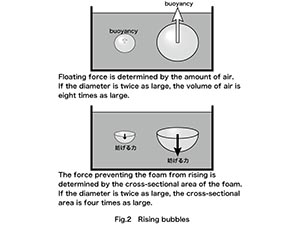Nagoya City Science Museum
TOP > Exhibition Guide > Keyword Search > Starting with "W" > water > Bubbles in the Water
Bubbles in the Water

Purpose of Exhibition
Water on the ground evaporates and turns into vapor. It soars upwards and makes clouds in the sky. Over time clouds are transformed into rain (water), which returns to the ground and pours into the ocean. Water circulates on the earth. In this "Exploring Water" exhibition, you can deepen your knowledge about this big circulation and characteristics of water through various experiments.
We will explain two exhibits in this "Oceanic Stage". Find out about the characteristic of bubbles.


Additional Knowledge
[White Water]
In a cylindrical tank, a ball is floating in the water. When you move a lever to make a lot of bubbles, the ball starts to sink. Why does this happen?
First, let’s think about why the ball floats in the water. When the ball is floating, part of it is underwater. This part gets a force called buoyancy, which helps the ball to float. The buoyancy force is equal to the weight of the water that has the same volume as the part of the ball underwater. So, if the weight of the water displaced by the ball is more than the weight of the ball, the ball floats. If it’s less, the ball sinks.
Now, let’s think about why the ball sinks when bubbles appear. When there are a lot of bubbles, the water level rises. This means the volume of water in the tank increases. However, the weight of the water stays the same, so the density of the water decreases. As a result, the weight of the water with the same volume as the ball becomes lighter. When this happens, the buoyancy force becomes weaker. The ball was floating perfectly without bubbles, so when the buoyancy force becomes a little weaker, the ball can’t stay afloat and starts to sink.
[Rising bubbles]
This experiment device makes bubbles rise by sending air from the bottom of the tank. You can change how you send the air to make bubbles of different sizes. Try making bubbles of different sizes and see how their rising speed changes. You will find that larger bubbles rise faster.
Why do larger bubbles rise faster? Bubbles rise because they get an upward force called buoyancy. This buoyancy force is equal to the weight of the water that has the same volume as the bubble. Since the whole bubble is underwater, the buoyancy force equals the weight of the water with the same volume as the bubble. If we assume the bubble is a sphere, its volume is proportional to the cube of its diameter. So, as the diameter of the bubble increases, the buoyancy force increases rapidly.
On the other hand, bubbles face resistance from the water as they rise. This resistance force depends on the cross-sectional area of the bubble, which is proportional to the square of its diameter.
Since the upward force is proportional to the cube of the diameter and the resistance force is proportional to the square of the diameter, the difference between the upward force and the resistance force grows larger as the diameter increases. This is why larger bubbles rise faster.
To make it easier to observe the bubbles rising slowly, the tank is filled with silicon oil, which has more resistance than water.
Article by YAMADA Yoshitaka, curator
